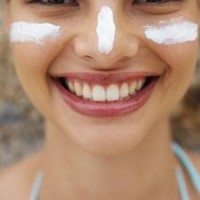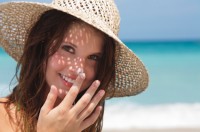Combination skin is characterized by a mixture of oiliness and dryness. Typically, the oily areas tend to be the T-zone, consisting of the forehead, nose and chin. The cheeks are normal to dry. The degrees of oiliness and dryness can vary. Pores may be larger in the oily areas – with pimples, blackheads and breakouts sometimes occurring – and dry areas may feel rough and irritated.
The “tissue test” can help you determine if you have combination skin. Take a tissue and hold/press it against your face. If there’s oil on the tissue where it touched your T-zone, but no oil where the tissue touched your cheeks, you most likely have combination skin.
Causes
Many factors can cause combination skin, including hormones, age, genetics, the way in which lipids are organized in our skin and even the weather. Hormonal changes can lead to changes in skin’s oiliness or dryness. Teens and young adults tend to have oilier skin, especially in the T-zone, but with age, hormones change and the oil production may decrease (but unfortunately, acne is still an issue for many adults). Also, hormones change due to menstruation and the birth control pill, which can make skin oilier in certain areas. Lipids also play a role in combination skin: These proteins affect skin’s softness and feel. When lipids aren’t evenly spread throughout the skin, certain areas will feel drier and rougher, while other areas may feel soft but oily or greasy. The organization of lipids in skin is due to genetics and hormones. Finally, weather can exacerbate combination skin. Dry cold weather can cause skin to dry out and become irritated. Conversely, hot humid weather can increase oil production. This can affect your T-zone as well as your cheeks.
Care Plan
Combination skin requires special care to balance the oily and dry areas of the face. Proper cleansing, treatment, moisturizing and sun protection are all necessary.
• Cleansing: People with combination skin often have difficulty finding a cleanser that works for their unique skin needs. Formulas designed for oily skin may leave combination skin too dry, especially in the cheeks, while formulas designed for dry skin may leave combination skin greasy, especially in the T-zone. It’s best to avoid products that are either too drying or too rich. Instead, use a foaming or gel cleanser to get rid of dirt and oil without causing irritation or dryness. A cleanser to try is one that removes excess oil and impurities while still being gentle and not drying out skin.
You should also exfoliate your skin regularly to remove dry, dead, rough skin cells. These cells may be particularly prominent on your cheeks. They can flake off and block pores, causing blemishes and blackheads. Try a product that might include papaya and pineapple juice, olive derivatives and Ginkgo Biloba
Treatments: Treatment products are another important skincare component, helping to balance your skin. One treatment to try is one which moisturizes dry areas but prevents excess oil, especially in the T-zone. This product also contains antioxidants to prevent aging. Another type of treatment is a mask, and you’ll find an array of products for every skin type. Some experts advise using a hydrating/moisturizing mask on dry areas (cheeks) and a deep-cleaning clay mask on oily areas (T-zone). While using two different masks is certainly an option, you can also use a mask specifically designed for combination skin. If you suffer from breakouts, which may occur around the T-zone, use acne treatment products with salicylic acid. For problem skin, try a blemish serum or a spot treatment.
Moisturize: Combination skin needs balance, and part of that balance means moisturizing your skin. Moisturizing is especially important for drier areas of the face, but your entire face needs moisture. Some experts suggest using separate moisturizers – a lightweight one for the T-zone and a deeper one for cheeks. You may choose to use separate moisturizers, but you can also use a single moisturizer designed for combination skin. Try a lotion which balances skin with witch hazel and aloe extract to help skin stay soft. Pay careful attention to dry areas, as they may require more frequent moisturizing than oily areas. Generally, experts recommend moisturizing dry areas twice a day and moisturizing oily areas once a day. Keep in mind that your individual skin has unique needs, so you might want to adjust your moisturizer – how often you use it, where you need it and how much you need.
Sun Protection: Like all other skin types, combination skin needs protection from the sun. UVA and UVB rays can damage skin, so use oil-free sunblock all over your face daily (and on any other exposed areas). Try an oil-free sunlotion or sunblock because it protects your skin from UV rays and won’t make skin greasy.
Natural Treatments
Natural treatments such as aromatherapy oils, home-made exfoliants and masks may help treat your combination skin. For example, try mixing essential oils like chamomile, lavender and ylang ylang (just a few drops) together with your oil-free moisturizer. These ingredients have antibacterial properties and may help to rid skin of dirt or bacteria. However, if your skin is sensitive or easily irritated, or if you’re pregnant, you shouldn’t use these essential oils.
Exfoliating treatments can be made at home by mixing and grinding nuts, seeds or oatmeal along with water. These will slough off dead, dry skin cells – especially common around the cheeks. You can add citrus peels from fruit – like orange or grapefruit – to the mix and apply it to the oily T-zone.
To make a mask for dry areas, use ingredients like yogurt, mashed bananas or avocados to moisturize. On oilier areas, try pureed strawberries and apples.






 Zinc Oxide Creams
Zinc Oxide Creams